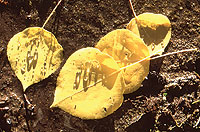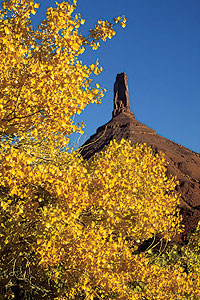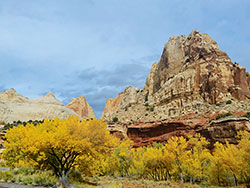Two aspects announce the approach of autumn in Canyon Country: cooler temperatures and changing leaves. From the mountains to the canyons, evidence of this seasonal change is hard to miss. 
With the changes in temperature and sunlight, many of the deciduous trees and shrubs begin to lose their verdant sheen. As chlorophyll compounds start to break down, other pigments become unmasked. These pigments, yellow xanthophylls, orange carotenoids, and red anthocyanins, give the leaves their non-green color.
Starting in the mountains, tracts of aspen turn golden in stark contrast to the neighboring dark-green conifers. Even from a distance, the changing aspen and oaks create mosaics of color visible from the valley floor. Other plants such as serviceberry, sumac, and wild rose also  add to this vibrancy but more as individual plants.
add to this vibrancy but more as individual plants.
As the leaves age, abscission cells begin to form at the base of the leaf’s stem due to the reduction of chlorophyll. Hormonal changes in the leaves signal the cells to degrade and start the process of shutting down leaf activity. The end result is the leaf detaching from the stem and fluttering to the ground.
Though the aspens will drop most of their leaves, the oaks seem to hold onto their dead leaves through the winter. The theory behind this is to protect next year’s buds from desiccating winter winds or hungry deer.
At lower elevations in the canyons, Fremont cottonwood and coyote willow paint streaks of gold along the streambanks. These ribbons of gold are often in stark contrast to the red rock canyon walls. If the temperatures stay mild through October, the leaves will continue this golden procession long into the fall. A sudden overnight freeze may cause the leaves to drop like a summer thunderstorm.
Even the non-native tamarisk that has survived the pressure of eradication, gets into the autumn action and adds some color to the riparian habitat along the region’s rivers and streams. Though efforts are underway to reduce this invasive species, its presence is a reminder of the tenacity of Nature under duress.
Here are a few suggested road trips along Scenic Byways to witness this spectacular seasonal transformation in southern Utah.
Soldier Summit
Highway 6 crosses over Soldier Summit, connecting Price to Spanish Fork. Gambel’s oak and quaking aspen form mosaics of color set against the dark greens of their neighboring conifers. When in peak color, this is a stunning show.

Indian Creek
Highway 211 follows Indian Creek past Dugout Ranch to the Needles District of Canyonlands National Park. The cottonwoods and willows that line the stream form a golden-yellow ribbon that contrasts with the towering red rock canyon walls. Remember to watch for climbers and cows; it’s easy to get distracted by the beauty of the area.
La Sal Mountains
The La Sal Mountain Loop Road provides excellent access up into this range that forms the backdrop to much of the Canyon Country below. Belts of Gambel’s oak, quaking aspen, and other shrubs ignite the slopes to the point you’ll want to yell, “There’s gold in them thar hills!”
Capitol Reef National Park
The Fremont River courses through the park along Highway 24. The golden-yellow cottonwood trees against the whitish Navajo sandstone domes form a very picturesque setting around every curve in the road. Dark, volcanic bombs are strewn about littering the sandstone benches and canyon floors, a sharp contrast to the golden leaves.